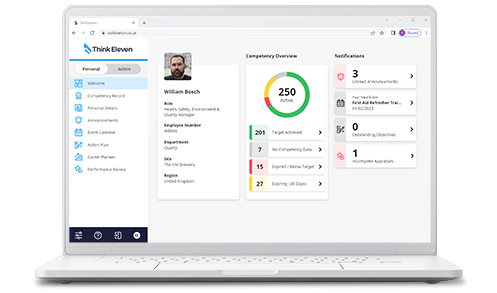In todays post, we look at the importance of skills and competency management for modern organisations. We'll cover the benefits of Competency Management Systems (CMS) for mapping skills, identifying gaps, and planning development, when compared to training matrix templates and Training Management Systems (TMS).
When it comes to workforce management, modern organisations need to move fast, with the necessity for effective skills and competency management being paramount. Keeping pace with technological advancements, adapting to changing workforce dynamics (e.g remote working), complying with evolving regulations, and an ongoing employee retention battle are all parts of a constant requirement to stay competitive, enhance agility, drive innovation, and meet customer quality and performance expectations.
By keeping focus on the skills and competencies of the workforce, organisations can ensure they are well-positioned to thrive and succeed in a complex and dynamic marketplace.
Effective management of skills and training records retention are crucial components of this process – to not only demonstrate current capability but to also effectively plot a course for future development that keeps you one step ahead of the competition. This article aims to explore the importance of competency management and highlights the best tools and techniques available for managing and tracking employee development.
Why Does Skills Management Matter?
Skills management is the systematic process of identifying, assessing, and developing the skills and competencies of employees. It ensures that the workforce remains agile, competitive, and aligned with the organisation's overall strategic goals. By effectively managing skills, companies can:
- Improve employee performance and productivity.
- Enhance job satisfaction and retention.
- Facilitate career development and succession planning.
- Comprehensively meet regulatory and compliance requirements.
The Role of a Competency Management Systems (CMS)
A Competency Management System (CMS) is a powerful tool that helps organisations manage, track, and report on the skills and competencies of their workforce. Key features of a CMS include:
- Competency mapping and assessment
- Skill gap analysis
- Development planning and tracking
- Reporting and analytics
Top Competency Management Tools
There are a variety of tools available, all with varying levels of capability. They can be broken down into three categories.
‘Free’ Software for Competency Management: For organisations on a tight budget, creating training matrix software in software such as Excel or Google Sheets can be a great starting point. These tools can provide basic functionality to track and manage training records but will fall short with the amount of admin work required to keep records accurate.
Training Matrix Software: A dedicated training matrix tool can help organisations more easily track the training and certification status of employees, whilst requiring a lot less work to maintain when compared to using spreadsheet software. This option begins to fall short when more detailed records of competence are required. Skills matrix software often lacks deeper insights into workforce capability and future development. These shortcomings are usually resolved by integrating with multiple other 3rd party systems to bridge gaps. For example, integration with a Learning Management System (LMS) to deliver content to employees.
Competency Management Software: These platforms offer comprehensive solutions for managing employee competence and capability. A good quality competency management system should include the full gamut of workforce development, including content delivery (Learning / Training), online / offline skills assessment tools, full tracking and reporting tools for easy admin and insights, as well as career planning and performance management functionalities.
Want a competency management system that can do everything? Check out SkillStation.
Training Records Retention and Management
Proper retention of training records is essential for compliance and audit purposes. Effective training records management ensures that all training activities are documented, accessible, and up-to-date. Key practices for managing training records include:
- Using digital platforms to store and organise records
- Implementing regular audits and updates
- Ensuring compliance with industry standards and regulations
A Competency Management System (CMS) Vs. A Training Management System (TMS): What Are the Benefits?
When comparing a Competency Management System (CMS) to a Training Management System (TMS), it's important to understand their distinct functionalities and benefits.
Competency Management System (CMS)
A CMS provides a holistic approach to managing employee skills and competencies, offering comprehensive features such as:
- Competency Mapping and Assessment: Identifies and evaluates the skills required for various roles within the organisation.
- Skill Gap Analysis: Helps in pinpointing areas where employees need further development.
- Development Planning and Tracking: Facilitates personalised learning paths and monitors progress.
- Reporting and Analytics: Delivers insights into workforce capabilities and development needs.
Training Management System (TMS)
A TMS focuses primarily on the administration and delivery of training programs, including:
- Content Delivery: Provides a platform for distributing training materials and courses.
- Training Scheduling: Manages the logistics of training sessions.
- Attendance Tracking: Records participation and completion of training activities.
Why a CMS Outperforms a TMS
While a TMS is useful for managing training logistics, a CMS offers broader benefits that contribute to overall workforce development:
- Integrated Approach: A CMS integrates competency mapping, skill assessments, and development planning, providing a comprehensive view of employee capabilities.
- Enhanced Analytics: With robust reporting tools, a CMS offers deeper insights into skill gaps and training effectiveness, enabling data-driven decision-making.
- Career and Succession Planning: A CMS supports long-term employee development by facilitating career planning and succession management.
- Compliance and Regulatory Adherence: Ensures that training and competency records are maintained in compliance with industry standards, reducing legal risks.
By adopting a CMS, organisations can ensure a more strategic and effective approach to workforce development, positioning themselves to thrive in a competitive and dynamic marketplace.
Conclusion
Effective skills and competency management is essential for modern organisations to navigate the complexities of today's dynamic marketplace. By leveraging a Competency Management System (CMS) and employing best practices in training records retention, companies can ensure their workforce remains agile, competitive, and aligned with strategic goals.
This can not only enhance employee performance and satisfaction but also support long-term career development and compliance with industry standards. By prioritising a comprehensive approach to managing skills and competencies, organisations position themselves for growth, innovation, and the ability to maintain a competitive edge.
Looking for the most competitive Competency Management Software on the market? Book a demo and free trial today!


